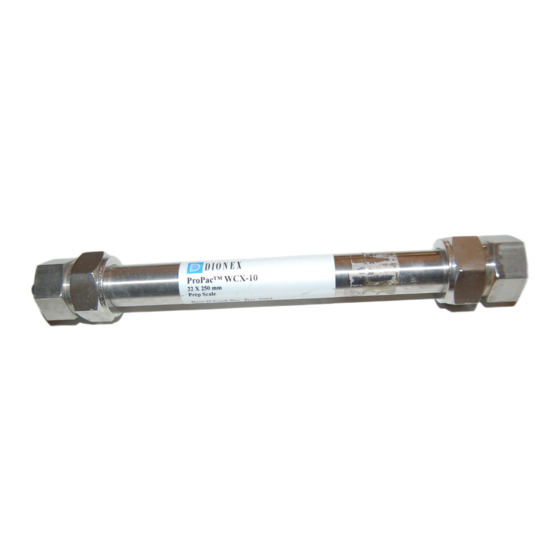
Table of Contents
Advertisement
Quick Links
ProPac WCX-10 Column Tips and Tricks Guide
Improving the Use of ProPac WCX-10 Column for
Monoclonal Antibody Variant Analysis and Characterization
The ProPac
WCX-10 column Tips and Tricks Guide provides helpful information and suggestions for improving the use of this column for
®
monoclonal antibody variant analysis and characterization. This guide highlights some key information and suggestions; please consult the
ProPac WCX-10 column manual for more detailed information and suggestions.
The ProPac WCX-10 column is a weak cation-exchange column designed specifically for the high-resolution, high-efficiency analysis of
monoclonal antibodies and associated variants. The unique nonporous pellicular resin provides exceptionally high resolving power, permitting
the separation of monoclonal antibody variants that differ by as little as one charged residue. Hydrophobic interactions with the resin are
essentially eliminated, resulting in highly efficient peaks. A proprietary grafted cation-exchange surface provides pH selectivity control,
resulting in high-resolution separations. The reproducible resin chemistry and manufacturing processes eliminate column variability as a
concern in stability and QA/QC testing
To ensure optimal performance of the ProPac WCX-10 columns, please observe the following suggestions.
Stainless Steel HPLC System & Column Poisoning:
Metal poisoning of ProPac WCX-10 columns can cause problems when Stainless Steel (SST) HPLC systems are used. Metal components in
SST systems corrode and form a metal complex (rust) when in contact with high salt concentration/low pH eluents. Metal complexes from the
corrosion will leach onto the column and inhibit its performance. To avoid these problems, we highly recommend using an inert HPLC system
for continued robust chromatography of monoclonal antibodies.
Suggestions:
Periodic passivation is required for stainless steel HPLC systems to reduce rust build up.
1. If you have experienced reproducibility and recovery problems, it could be due to the metal poisoning from one or several SST components
in your HPLC system. Restoring the column to original metal-free status is a tedious and time consuming process. However, it can
be achieved by treating the column with oxalic acid dihydrate (200 mM) at 0.2 mL/min for 6 h followed by a 20 mM NaOH wash for
30 min at 0.5 mL/min. Please equilibrate your column thoroughly for an extended period of time (1 to 2 h) before testing with your
sample of interest. Please note: treatment requires an inert device for pumping the oxalate or high pH eluents.
Advertisement
Table of Contents

Summary of Contents for Dionex ProPac WCX-10
- Page 1 Stainless Steel HPLC System & Column Poisoning: Metal poisoning of ProPac WCX-10 columns can cause problems when Stainless Steel (SST) HPLC systems are used. Metal components in SST systems corrode and form a metal complex (rust) when in contact with high salt concentration/low pH eluents. Metal complexes from the corrosion will leach onto the column and inhibit its performance.
- Page 2 • Sample Load: The ProPac WCX-10 column is based on nonporous particles. Typically about 100 μg can be loaded on a 4 × 250 mm format column. Please follow the procedures given in the ProPac WCX-10 column manual to recover a fouled column.








Need help?
Do you have a question about the ProPac WCX-10 and is the answer not in the manual?
Questions and answers